Camassia, common name camas, is a genus of perennial plants native to North America. Some species of camas produce edible bulbs that have been historically used as a food source by Native American indigenous peoples; these species are camassia quamash (common camas), and camassia leichtlinii (great camas).
These edible camas bulbs are an important traditional food with cultural and historical significance.
Edible Camassia Species
Several species of camassia, commonly known as camas, produce edible bulbs that have historical and cultural significance as a food source for Indigenous peoples in North America.
Two primary species are commonly recognized for their edible bulbs.
What Are You Foraging For Right Now?
We're thrilled to hear your ideas. What would you like to submit today? Feel free to share your thoughts and experiences with us.
Common/Blue Camas (Camassia quamash)
- Also known as quamash, blue camas, or Indian wild hyacinth.
- Range: Common camas is found in various parts of North America, including the western United States and Canada.
- Bulbs: The bulbs are starchy and have a sweet, nutty flavor when properly prepared.
- Harvesting: Common camas bulbs are typically harvested in late spring or early summer when the plant is in its vegetative phase.
Great Camas (Camassia leichtlinii)
- Also known as large camas or Leichtlin’s camas.
- Range: Great camas is found in parts of the western United States and Canada, often in higher elevation meadows.
- Bulbs: The bulbs are starchy and edible, similar to those of common camas.
- Harvesting: Great camas bulbs are also typically harvested in late spring or early summer.
It’s important to note that while these native plant species produce edible bulbs, not all species of camas are suitable for consumption, and some can be toxic.

Other wild plants with edible bulbs you might be interested in reading about:
How To Identify Edible Camassia?
Camassia Quamash Physical Characteristics
Plant Height: Common camas typically grows to a height of 1 to 2 feet (30 to 60 cm).
Leaves: The plant has long, narrow, grass-like leaves. The leaves are basal, meaning they grow in a rosette close to the ground.
Flower Stalks: Common camas produces tall, slender flower stalks that can reach up to 3 feet (90 cm) in height.
Flowers: The flowers of Camassia quamash are bell-shaped and range in color from light to deep blue. Occasionally, they can also be white or purple. Each flower has six petal-like segments, and the flowers are arranged in a spike-like cluster at the top of the stalk.
Bulbs: The edible part of common camas is its bulb, which is usually round or elongated and covered in a brown, papery skin. The bulbs can be several inches in diameter.
Bloom Time: Common camas usually blooms in late spring to early summer. The flowers can be quite striking when they cover the plant’s tall stalks in a cluster.
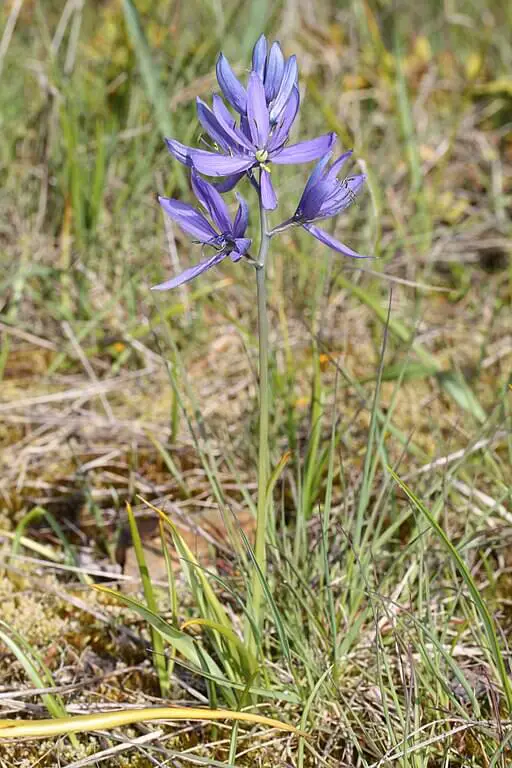
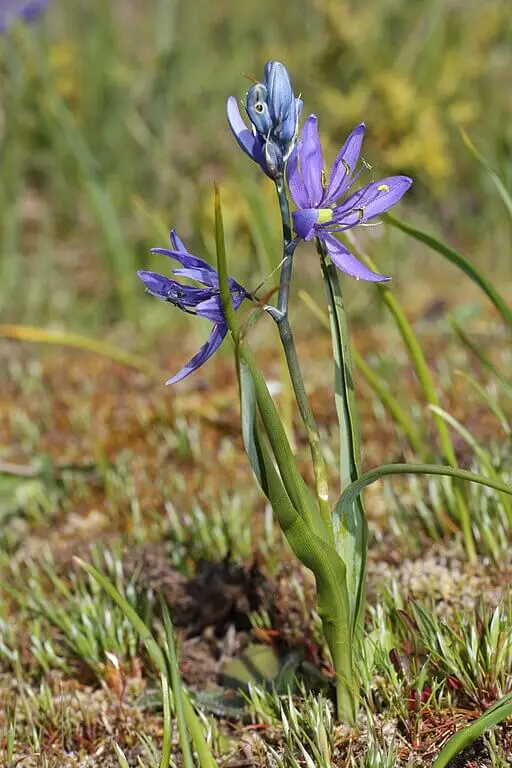
Camassia leichtlinii Physical Characteristics
Plant Height: Great camas typically grows to a height of 1 to 3 feet (30 to 90 cm).
Leaves: The plant has long, narrow, grass-like leaves. The leaves are basal, meaning they grow in a rosette close to the ground.
Flower Stalks: Great camas produces tall, slender flower stalks that can reach up to 3 feet (90 cm) in height.
Flowers: Camassia leichtlinii has star-shaped flowers that typically range in color from light to deep blue, although white or blue-violet varieties can also occur. Each flower has six petal-like segments, and the flowers are arranged in a spike-like cluster at the top of the stalk.
Bulbs: The edible part of great camas is its bulb, which is usually round or elongated and covered in a brown, papery skin. The bulbs can be several inches in diameter and are similar in appearance to those of common camas (Camassia quamash).
Bloom Time: Great camas usually blooms in late spring to early summer. The flowers can create impressive displays when they cover the plant’s tall flower stalks in a cluster.
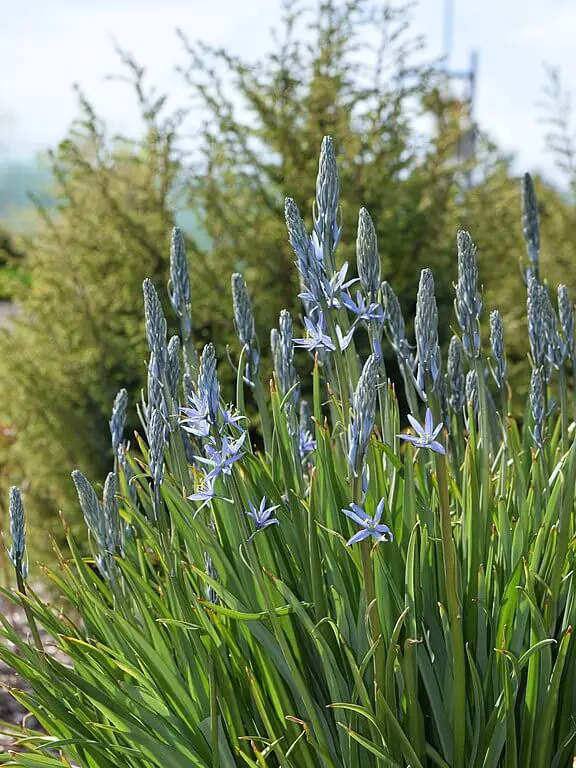
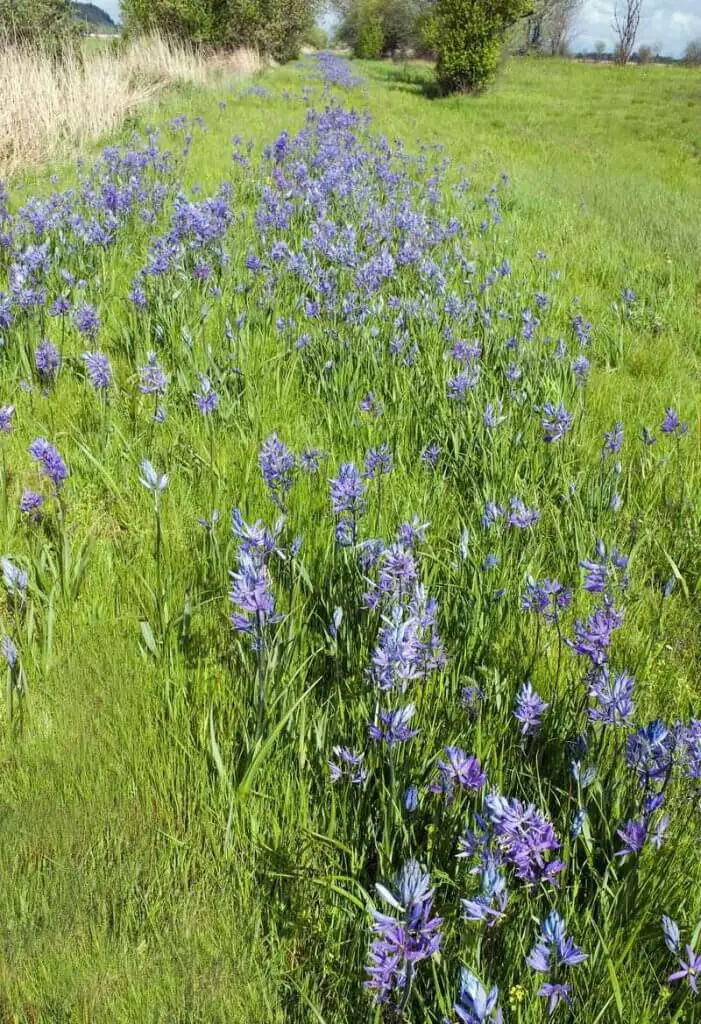
What part of the common and great camas is edible?
Both the common camas (Camassia quamash) and great camas (Camassia leichtlinii) have edible bulbs, which are the edible part of the plant.
What does the camassia bulb taste like?
The primary taste of camas bulbs is sweetness. They have a natural sweetness that is somewhat similar to roasted chestnuts or sweet potatoes.
Camas bulbs can become tender and somewhat creamy in texture when properly cooked. This texture contributes to their culinary versatility.
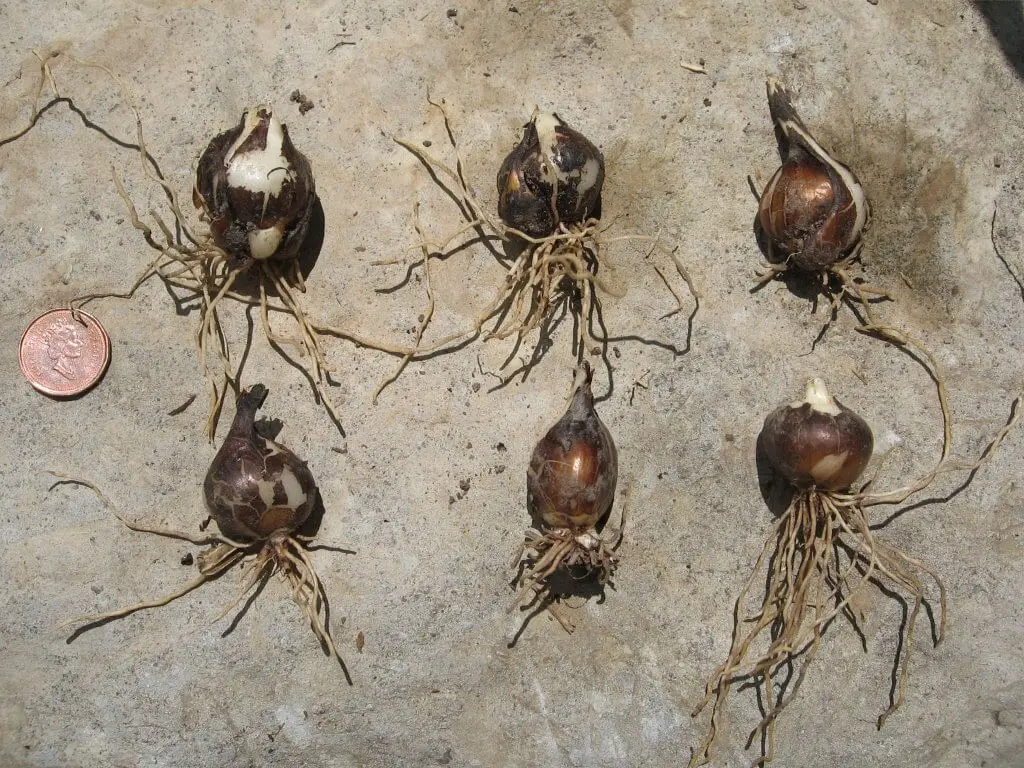
How to Cook Camassia bulbs?
Camas bulbs must be prepared correctly to make them safe to eat. They contain naturally occurring bitter compounds that can be toxic if not processed correctly. Traditional methods for preparation include:
- Slow-Roasting: This involves placing the cleaned bulbs in a fire or oven and slow-roasting them until they become soft and sweet.
- Steaming: Another method is to steam the bulbs until they are thoroughly cooked.
- Pit-Cooking: In some Indigenous traditions, camas bulbs are pit-cooked in earth ovens, where they are placed in a pit lined with heated rocks and covered with soil or other insulating materials.
Once properly prepared, camas bulbs can be eaten as a vegetable. They have a sweet and nutty taste, similar to roasted chestnuts. They can be used in various culinary preparations, such as soups, stews, or simply as a side dish.
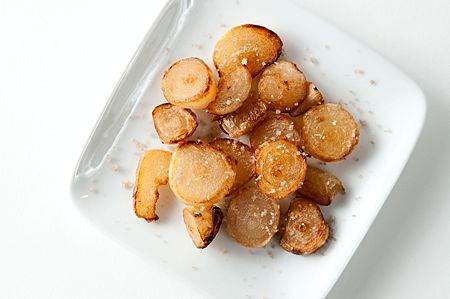

Foraging for Camassia Squamash & Camassia leichtlinii
Where to forage
- Pacific Northwest: Common and great camas is abundant in the Pacific Northwest, including states such as Washington, Oregon, and Idaho. These states have a variety of suitable habitats, including meadows, grasslands, and open woodlands, where you can find this plant.
- California: Some parts of California, especially in the northern and central regions, have suitable habitats for common and great camas. Look for it in meadows and grassy areas.
- Rocky Mountains: Common and great camas can also be found in the Rocky Mountain states of Montana, Wyoming, and Colorado, particularly in areas with moist meadows and grasslands.
- Intermountain West: States like Utah and Nevada, which are part of the Intermountain West region, may have suitable habitats for common and great camas.
- Great Basin: Common and great camas may be found in parts of the Great Basin region, which includes parts of Nevada and adjacent states.
When to forage
Early Summer: The bulbs of common and great camas are best harvested in early summer, typically from late May to early July, depending on the region. This is when the bulbs are at their most plump and contain the highest levels of stored energy.
Flowering Stage: Some foragers prefer to harvest camas bulbs before the plant reaches full flowering, as the bulbs are larger and have not yet converted their stored energy into flowering and seed production.
Camassia squamash and leichtlinii lookalikes
While both common camas and great camas are generally safe to eat when prepared correctly, some plants may resemble them and could be harmful or toxic. Here are some toxic lookalikes to be cautious of:
1. Death Camas (Toxic):
The most significant toxic lookalike for common and great camas is the death camas plant (genus Zigadenus), which includes species like Zigadenus venenosus.
- Death camas contains toxic alkaloids that can be lethal if ingested. It is not recommended to forage for death camas, as it can be challenging to distinguish from edible camas species, especially when not in bloom.
- One key distinguishing feature is that death camas typically has white or greenish-white flowers, while camas species have blue, purple, or occasionally white or purple flowers.
- Foragers should exercise extreme caution and rely on expert guidance to differentiate between these plants.
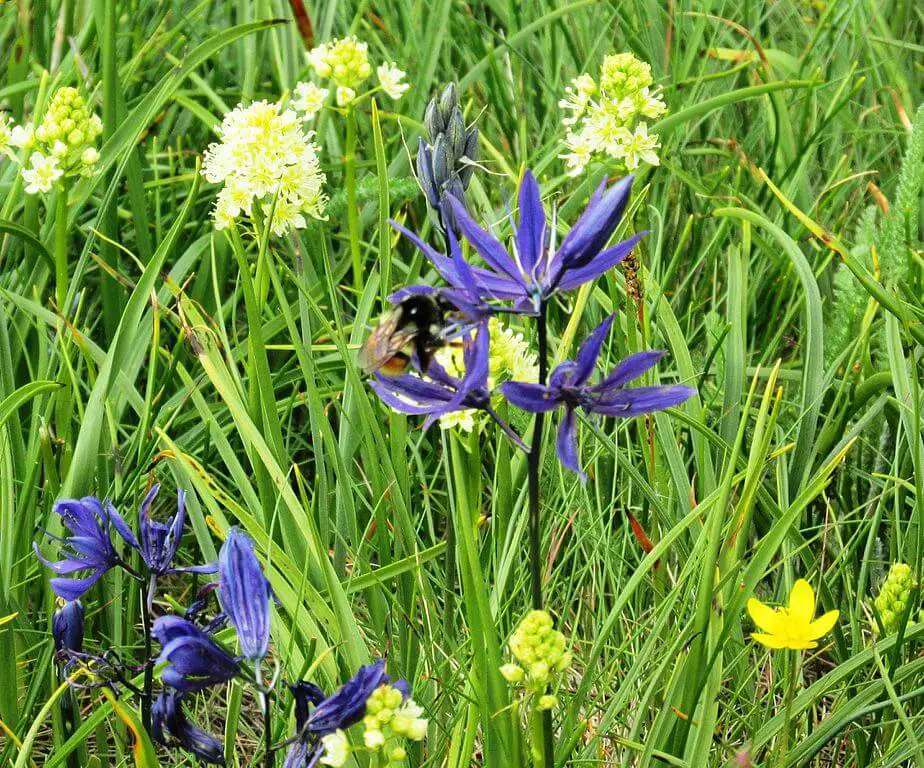

2. Wild Onion and Wild Garlic (Edible):
- Wild onion (Allium species) and wild garlic (Allium ursinum/Allium tricoccum) can resemble common camas in terms of their grass-like leaves and growth habitat.
- While wild onions and wild garlic are generally edible, there is always the potential for misidentification, especially when the plants are not in bloom.
- Pay attention to the smell of the bulbs or leaves; wild onions and garlic typically have a distinct onion or garlic scent, which common camas lacks.
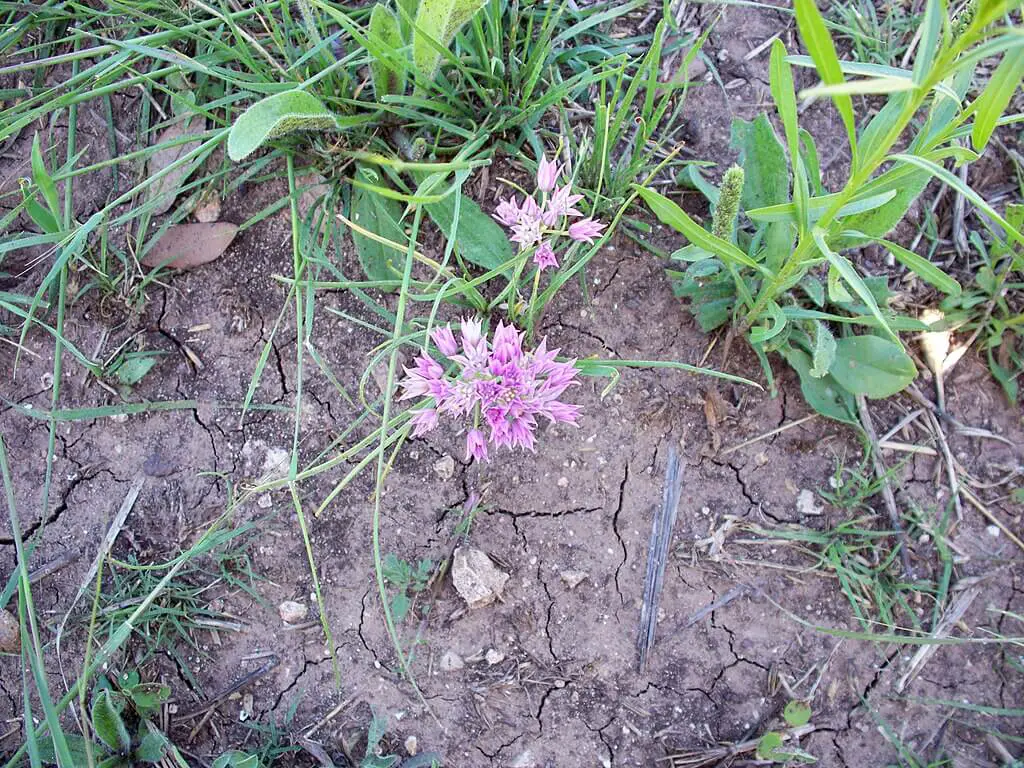

Ana has always been interested in all things nature and flora. With her expertise in home gardening and interest in foraging, she has been spending her weekends and free time looking for edible native plants, flowers, and fungi. One of her many hobbies includes testing new savory and sweet recipes, juices or teas made from freshly picked plants, wild fruits, or mushrooms.

